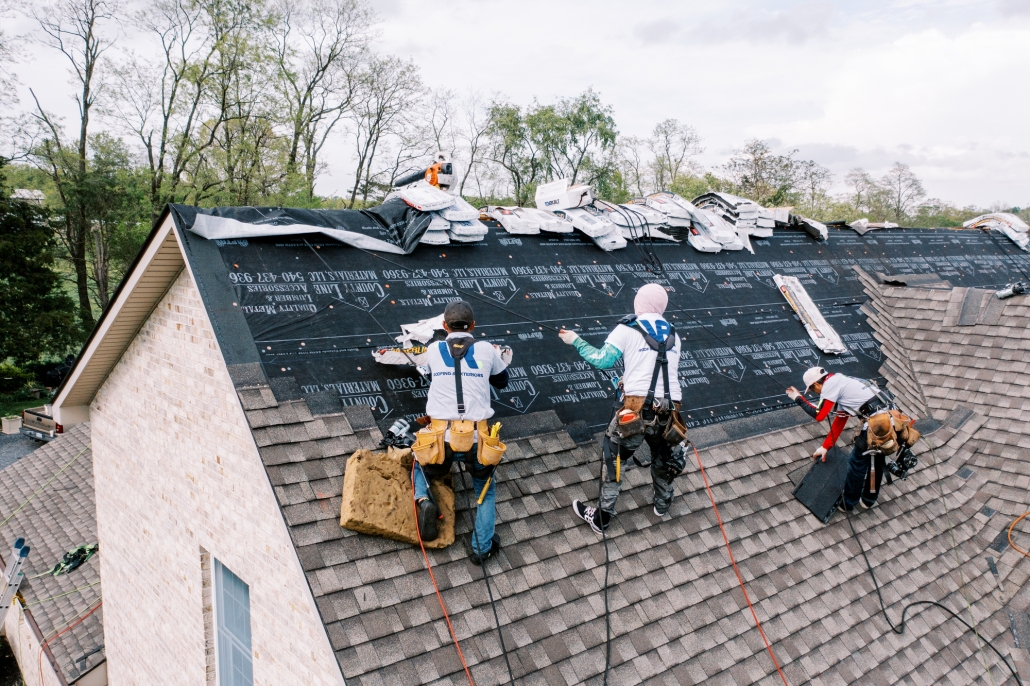Vital Questions to Ask Gainesville Roofing Companies Before Hiring
Vital Questions to Ask Gainesville Roofing Companies Before Hiring
Blog Article
Ideal Practices for Ensuring Correct Roof Ventilation
A balanced intake and exhaust air vent ratio, typically 1:300, plays an essential function, with consumption vents preferably put at the lower edge of the roofing for great air entry and exhaust vents at the height for warm air departure. Maintaining insulation away from vents is crucial to prevent air flow constraint.
Understand Ventilation Essentials
Properly comprehending air flow essentials is crucial for making sure the longevity and effectiveness of roof. Efficient air flow mitigates dampness build-up and temperature extremes in the attic room, both of which can bring about considerable architectural damage with time. A well-ventilated roof covering helps in avoiding typical issues such as mold and mildew development, wood rot, and ice dams, which can endanger the integrity of the roof covering products and the underlying structures.
The primary goal of air flow is to facilitate the movement of air, enabling a consistent exchange in between the indoor and outdoor environments. This equilibrium is achieved with a mix of intake and exhaust vents that function with each other to maintain optimal airflow. Consumption vents, usually situated along the eaves or soffits, enable fresh air to get in the attic room area, while exhaust vents, often positioned at or near the roofing ridge, make it possible for hot, damp air to leave.
Secret variables affecting the performance of roof ventilation include correct placement, appropriate sizing, and making sure that both intake and exhaust vents are unblocked. Regular inspection and maintenance are crucial to determine prospective blockages, damages, or inadequacies in the air flow system, consequently securing the roofing's performance and sturdiness.
Kinds of Roofing System Vents
Roof covering vents play an important function in keeping effective attic air flow and, by extension, the overall wellness of the roof covering system. Different types of roof vents are readily available, each with special advantages customized to details roofing requirements.

Soffit vents are installed under the eaves and job in tandem with roof vents to guarantee a balanced intake and exhaust system. By enabling cooler air to get in from below, soffit vents facilitate the expulsion of warm air via top vents. Gable vents, located on the exterior wall surfaces of the attic, offer one more effective remedy, particularly in homes with saddleback roofs.
Analyze Your Present Ventilation

Following, think about the age and condition of your roof materials and air flow parts. Older systems may not follow present structure codes or might have deteriorated gradually, decreasing their efficiency. Conduct a detailed assessment to determine any kind of indicators of damage, such as corrosion, damages, or gaps that could endanger the system's efficiency.
In addition, measure the attic temperature level and humidity degrees. High temperatures and humidity can show inadequate air flow.
Installment Best Practices
Effective installation of roof covering air flow systems is critical for making sure ideal performance and longevity. Correct installation begins with understanding the particular air flow visit demands of the building and the roof it covers. This involves computing the right proportion of intake to exhaust vents, normally adhering to the 1:300 guideline, which specifies one square foot of ventilation for every single 300 square feet of attic flooring room.

The placement of vents is similarly critical. Intake vents ought to be mounted at the roofing's reduced edge, usually in the soffits, to permit great air to get in. Exhaust vents, on the other hand, ought to be set up near or at the roof covering's peak to facilitate the leave of cozy, damp air. This develops a natural air movement that aids preserve temperature level and dampness equilibrium within the attic space.
Seal all air vent connections carefully to avoid air leaks and possible water seepage. Usage high-grade materials and follow producer standards to make sure longevity and effectiveness. Additionally, integrating ridge vents with baffles can considerably improve air flow performance by protecting against wind-driven rainfall and snow from getting in the attic.
Eventually, exact installation of roof covering air flow systems mitigates prospective issues such as mold and mildew growth, ice dams, and structural damage, ensuring the roofing system's honesty and the structure's overall health and wellness.
Routine Upkeep Tips
Consistency in maintenance techniques is basic to making certain the lasting performance of roof air flow systems. During these examinations, Website make sure that vents are cost-free of debris, nests, and various other blockages that could hinder airflow.
Utilize a soft brush or a vacuum to eliminate dirt and particles from intake and exhaust vents. Be mindful not to damage the air vent displays or louvers throughout the process.
Correct insulation is similarly important. Guarantee that attic insulation does not block the vents, as this can severely limit air movement. Rearrange or replace it to preserve a reliable barrier. if any kind of insulation has actually moved or cleared up.
Lastly, change any type of damaged or missing out on elements promptly. Busted vents, fractured shingles, or tatty blinking can all add to poor ventilation and should be attended to without delay. Regular upkeep ensures that the roofing air flow system operates ideally, thereby extending the life expectancy of the roof itself.
Conclusion
Making certain correct roofing ventilation is vital for keeping the effectiveness and toughness of a roof. Adherence to the 1:300 consumption and exhaust air vent ratio, paired with the tactical positioning of vents, is necessary. Routine semiannual assessments, debris cleaning, and making certain insulation does not block airflow are critical methods. Applying these ideal methods will certainly cultivate a well-ventilated roof, therefore minimizing possible issues associated with moisture buildup and too much heat, eventually extending the roof covering's life-span.
A balanced intake and exhaust vent proportion, frequently 1:300, plays a crucial duty, with intake vents ideally put at the lower edge of the roofing system for trendy air entry and exhaust vents at the optimal for cozy air exit. Consumption vents, typically situated along the soffits or eaves, permit fresh air to enter the attic room, while exhaust vents, usually situated at or near the roof covering ridge, enable warm, humid air to run away.
Soffit vents are set up under the eaves and work in tandem with roof covering vents to guarantee a well balanced consumption and exhaust system. By permitting cooler air to go into from below, soffit vents facilitate the expulsion of warm air via upper vents. Adherence to the 1:300 intake and exhaust air webpage vent ratio, combined with the calculated placement of vents, is important.
Report this page